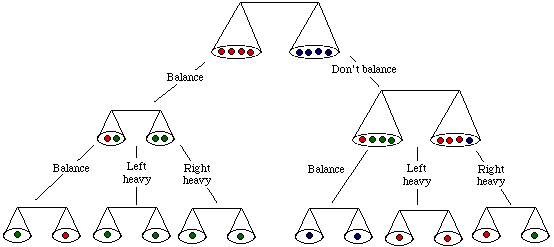![]()
Quandaries
and Queries
My Grandson (age 15 in the 9th grade) has asked me the following questions and I told him I would try to find out how to solve them.
- There are 12 coins which look exactly the same, however one of them
is heavier than the rest. Using a pointer balance scale, can you identify
the odd coin in 3 weighings?
- Using problem 1 above, follow the same directions except the odd coin could be lighter or heavier.
Hi Jack
I will give you a detailed answer to question 2. This also answers question 1, but question 1 can be done in a number of ways. Can you do it starting with 5 coins on each side? 6 on each side?

Second weighing
- If they balance then the odd coin is the one green that has not
been weighed.
Third weighing
- If, on the second weighing, the left side is heavy then
either the green coin on the left is too heavy or one of the
green coins on the right is too light.
Third weighing
- If, on the second weighing, the left side
is light then either the green coin on the
left is too light or one of the green coins
on the right is too heavy.
Third weighing
Second weighing
- If they balance then one of the three blues not weighed on the second
weighing is the odd coin, and you can tell by the first weighing whether
it is too light or too heavy.
Third weighing
- If the left side is heavy then either the red coin on the
left is heavy or the blue coin on the right is light.
Third weighing
- If the right side is heavy then either the
red coin on the left is light or the blue coin
on the right is heavy.
Third weighing
Cheers
Harley